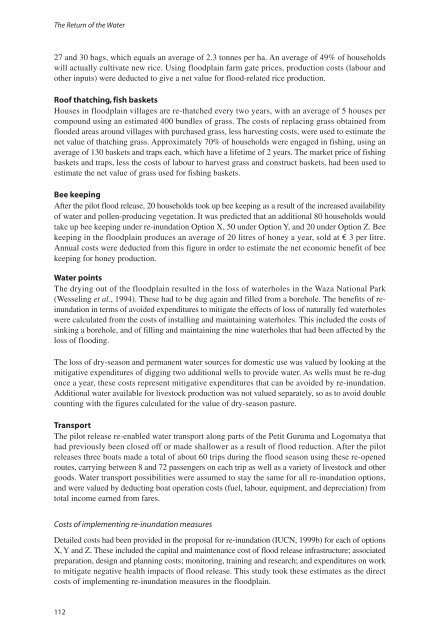The return of the water - IUCN
The return of the water - IUCN
The return of the water - IUCN
You also want an ePaper? Increase the reach of your titles
YUMPU automatically turns print PDFs into web optimized ePapers that Google loves.
<strong>The</strong> Return <strong>of</strong> <strong>the</strong> Water<br />
27 and 30 bags, which equals an average <strong>of</strong> 2.3 tonnes per ha. An average <strong>of</strong> 49% <strong>of</strong> households<br />
will actually cultivate new rice. Using floodplain farm gate prices, production costs (labour and<br />
o<strong>the</strong>r inputs) were deducted to give a net value for flood-related rice production.<br />
Ro<strong>of</strong> thatching, fish baskets<br />
Houses in floodplain villages are re-thatched every two years, with an average <strong>of</strong> 5 houses per<br />
compound using an estimated 400 bundles <strong>of</strong> grass. <strong>The</strong> costs <strong>of</strong> replacing grass obtained from<br />
flooded areas around villages with purchased grass, less harvesting costs, were used to estimate <strong>the</strong><br />
net value <strong>of</strong> thatching grass. Approximately 70% <strong>of</strong> households were engaged in fishing, using an<br />
average <strong>of</strong> 130 baskets and traps each, which have a lifetime <strong>of</strong> 2 years. <strong>The</strong> market price <strong>of</strong> fishing<br />
baskets and traps, less <strong>the</strong> costs <strong>of</strong> labour to harvest grass and construct baskets, had been used to<br />
estimate <strong>the</strong> net value <strong>of</strong> grass used for fishing baskets.<br />
Bee keeping<br />
After <strong>the</strong> pilot flood release, 20 households took up bee keeping as a result <strong>of</strong> <strong>the</strong> increased availability<br />
<strong>of</strong> <strong>water</strong> and pollen-producing vegetation. It was predicted that an additional 80 households would<br />
take up bee keeping under re-inundation Option X, 50 under Option Y, and 20 under Option Z. Bee<br />
keeping in <strong>the</strong> floodplain produces an average <strong>of</strong> 20 litres <strong>of</strong> honey a year, sold at € 3 per litre.<br />
Annual costs were deducted from this figure in order to estimate <strong>the</strong> net economic benefit <strong>of</strong> bee<br />
keeping for honey production.<br />
Water points<br />
<strong>The</strong> drying out <strong>of</strong> <strong>the</strong> floodplain resulted in <strong>the</strong> loss <strong>of</strong> <strong>water</strong>holes in <strong>the</strong> Waza National Park<br />
(Wesseling et al., 1994). <strong>The</strong>se had to be dug again and filled from a borehole. <strong>The</strong> benefits <strong>of</strong> reinundation<br />
in terms <strong>of</strong> avoided expenditures to mitigate <strong>the</strong> effects <strong>of</strong> loss <strong>of</strong> naturally fed <strong>water</strong>holes<br />
were calculated from <strong>the</strong> costs <strong>of</strong> installing and maintaining <strong>water</strong>holes. This included <strong>the</strong> costs <strong>of</strong><br />
sinking a borehole, and <strong>of</strong> filling and maintaining <strong>the</strong> nine <strong>water</strong>holes that had been affected by <strong>the</strong><br />
loss <strong>of</strong> flooding.<br />
<strong>The</strong> loss <strong>of</strong> dry-season and permanent <strong>water</strong> sources for domestic use was valued by looking at <strong>the</strong><br />
mitigative expenditures <strong>of</strong> digging two additional wells to provide <strong>water</strong>. As wells must be re-dug<br />
once a year, <strong>the</strong>se costs represent mitigative expenditures that can be avoided by re-inundation.<br />
Additional <strong>water</strong> available for livestock production was not valued separately, so as to avoid double<br />
counting with <strong>the</strong> figures calculated for <strong>the</strong> value <strong>of</strong> dry-season pasture.<br />
Transport<br />
<strong>The</strong> pilot release re-enabled <strong>water</strong> transport along parts <strong>of</strong> <strong>the</strong> Petit Guruma and Logomatya that<br />
had previously been closed <strong>of</strong>f or made shallower as a result <strong>of</strong> flood reduction. After <strong>the</strong> pilot<br />
releases three boats made a total <strong>of</strong> about 60 trips during <strong>the</strong> flood season using <strong>the</strong>se re-opened<br />
routes, carrying between 8 and 72 passengers on each trip as well as a variety <strong>of</strong> livestock and o<strong>the</strong>r<br />
goods. Water transport possibilities were assumed to stay <strong>the</strong> same for all re-inundation options,<br />
and were valued by deducting boat operation costs (fuel, labour, equipment, and depreciation) from<br />
total income earned from fares.<br />
Costs <strong>of</strong> implementing re-inundation measures<br />
Detailed costs had been provided in <strong>the</strong> proposal for re-inundation (<strong>IUCN</strong>, 1999b) for each <strong>of</strong> options<br />
X, Y and Z. <strong>The</strong>se included <strong>the</strong> capital and maintenance cost <strong>of</strong> flood release infrastructure; associated<br />
preparation, design and planning costs; monitoring, training and research; and expenditures on work<br />
to mitigate negative health impacts <strong>of</strong> flood release. This study took <strong>the</strong>se estimates as <strong>the</strong> direct<br />
costs <strong>of</strong> implementing re-inundation measures in <strong>the</strong> floodplain.<br />
112












